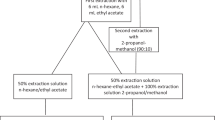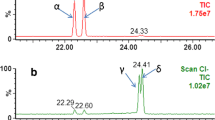Abstract
The levels of 22 phthalate diesters (phthalates) and organophosphate triesters (organophosphates) have been investigated in standard reference material 2585 (SRM 2585) “organic contaminants in house dust.” Ultrasonic-assisted solvent extraction and solid-phase extraction on a Florisil adsorbent were used as the extraction and cleanup steps combined with analysis using gas chromatography–tandem mass spectrometry in positive ion chemical ionization mode. Seven phthalates were detected in the concentration range 1–570 μg/g. Di(2-ethylhexyl) phthalate was the major phthalate present at 570 μg/g. Ten organophosphates were detected in SRM 2585. Tris(2-butoxyethyl) phosphate was the predominant organophosphate at 82 μg/g, and nine organophosphates were determined at concentrations ranging from 0.19 to 2.3 μg/g. Five organophosphates were below the method detection limit, of which two were in level with the procedural blank. The applied extraction and cleanup method was evaluated for the analysis of SRM 2585. The extraction yield was ≥99%, except for tris(2-chloroethyl) phosphate (97%) and diethyl phthalate (98.5%). The problem of calibration curvature is addressed, and it is shown that the use of deuterated standards improves the analysis. The concentrations of ten organophosphate esters were determined in SRM 2585, and seven of these were compared with existing data. To our knowledge, this is the first report of the levels of the seven phthalates esters in SRM 2585 “organic contaminants in house dust.”



Similar content being viewed by others
References
Weschler CJ, Nazaroff WW (2008) Semivolatile organic compounds in indoor environments. Atmos Environ 42:9018
Garcia-Jares C, Regueiro J, Barro R et al (2009) Analysis of industrial contaminants in indoor air. Part 2. Emergent contaminants and pesticides. J Chromatogr A 1216:567
Morawska L, Salthammer T (2003) Indoor environment: airborn particles and settled dust. Wiley-VCH, Weinheim
NIST (2010) Certificate of analysis for SRM 2585 organic contaminants in house dust. Last certificate revision: 06 January 2010. Original certificate date: 20 December 2005
Gächter R, Müller H (1993) Plastic additives. Hanser/Gardner Publications, Cincinatti
Wensing M, Uhde E, Salthammer T (2005) Plastics additives in the indoor environment—flame retardants and plasticizers. Sci Total Environ 339:19
Weschler CJ, Nazaroff WW (2010) SVOC partitioning between the gas phase and settled dust indoors. Atmos Environ 44:3609
Ayoko GA, Uhde E (2003) In: Morawska L, Salthammer T (eds) Indoor environment: airborn particles and settled dust. Wiley-VCH, Weinheim
Weschler CJ, Salthammer T, Fromme H (2008) Partitioning of phthalates among the gas phase, airborne particles and settled dust in indoor environments. Atmos Environ 42:1449
Reemtsma T, Garcia-Lopez M, Rodriguez I et al (2008) Organophosphorus flame retardants and plasticizers in water and air I. Occurrence and fate. TrAC, Trends Anal Chem 27:727
Fromme H, Lahrz T, Piloty M et al (2004) Occurrence of phthalates and musk fragrances in indoor air and dust from apartments and kindergartens in Berlin (Germany). Indoor Air 14:188
Marklund A, Andersson B, Haglund P (2003) Screening of organophosphorus compounds and their distribution in various indoor environments. Chemosphere 53:1137
Carlsson H, Nilsson U, Becker G et al (1997) Organophosphate ester flame retardants and plasticizers in the indoor environment: analytical methodology and occurrence. Environ Sci Technol 31:2931
Staaf T, Östman C (2005) Organophosphate triesters in indoor environments. J Environ Monit 7:883
Bergh C, Torgrip R, Emenius G et al (2011) Organophosphate and phthalate esters in air and settled dust—a multi-location indoor study. Indoor Air 21:67
Kanazawa A, Saito I, Araki A et al (2010) Association between indoor exposure to semi-volatile organic compounds and building-related symptoms among the occupants of residential dwellings. Indoor Air 20:72
Bornehag C, Sundell J, Weschler CJ et al (2004) The association between asthma and allergic symptoms in children and phthalates in house dust: a nested case–control study. Environ Health Perspect 112:1393
Bornehag C, Lundgren B, Weschler CJ et al (2005) Phthalates in indoor dust and their association with building characteristics. Environ Health Perspect 113:1399
Langer S, Weschler CJ, Fischer A et al (2010) Phthalate and PAH concentrations in dust collected from Danish homes and daycare centers. Atmos Environ 44:2294
Nagorka R, Scheller C, Ullrich D (2005) Weichmacher im Hausstaub [Plasticizers in house dust]. Gefahrst Reinhalt L 65:99
Nagorka R, Ullrich D (2003) Determination of organophosphorus flame retardants in indoor dust: screening method with GC/NPD. Gefahrst Reinhalt L 63:79
Garcia M, Rodriguez I, Cela R (2007) Microwave-assisted extraction of organophosphate flame retardants and plasticizers from indoor dust samples. J Chromatogr A 1152:280
Garcia M, Rodriguez I, Cela R (2007) Optimisation of a matrix solid-phase dispersion method for the determination of organophosphate compounds in dust samples. Anal Chim Acta 590:17
Rudel RA, Camann DE, Spengler JD et al (2003) Phthalates, alkylphenols, pesticides, polybrominated diphenyl ethers, and other endocrine-disrupting compounds in indoor air and dust. Environ Sci Technol 37:4543
Bergh C, Torgrip R, Östman C (2010) Simultaneous selective detection of organophosphate and phthalate esters using gas chromatography with positive ion chemical ionization tandem mass spectrometry and its application to indoor air and dust. Rapid Commun Mass Spectrom 24:2859
Quintana JB, Rodil R, Reemtsma T et al (2008) Organophosphorus flame retardants and plasticizers in water and air II. Analytical methodology. TrAC, Trends Anal Chem 27:904
Schantz MM, Keller JM, Kucklick JR et al (2007) New standard reference material (SRM) 2585: organic contaminants in house dust to support exposure assessment measurements. Am Lab 39:22
Poster DL, Kucklick JR, Schantz MM et al (2007) Development of a house dust standard reference material for the determination of organic contaminants. Environ Sci Technol 41:2861
Stapleton HM, Harner T, Shoeib M et al (2006) Determination of polybrominated diphenyl ethers in indoor dust standard reference materials. Anal Bioanal Chem 384:791
Wise SA, Poster DL, Kucklick JR et al (2006) Standard reference materials (SRMs) for determination of organic contaminants in environmental samples. Anal Bioanal Chem 386:1153
Van den Eede N, Dirtu AC, Neels H et al (2011) Analytical developments and preliminary assessment of human exposure to organophosphate flame retardants from indoor dust. Environ Int 37:454
Abb M, Heinrich T, Sorkau E et al (2009) Phthalates in house dust. Environ Int 35:965
Acknowledgments
This work has been partly funded by the City of Stockholm Environment and Health Administration and the Stockholm County Council. We thank Carmen Veneri for laboratory assistance during her undergraduate work at the department. We also gratefully acknowledge Professor Åke Bergman and Ioannis Athanassiadis at the Department of Material and Environmental Chemistry, Stockholm University, for access and instrumental support of the Varian GC-MS system.
Author information
Authors and Affiliations
Corresponding author
Additional information
Published in the 10th Anniversary Issue.
Rights and permissions
About this article
Cite this article
Bergh, C., Luongo, G., Wise, S. et al. Organophosphate and phthalate esters in standard reference material 2585 organic contaminants in house dust. Anal Bioanal Chem 402, 51–59 (2012). https://doi.org/10.1007/s00216-011-5440-2
Received:
Revised:
Accepted:
Published:
Issue Date:
DOI: https://doi.org/10.1007/s00216-011-5440-2




